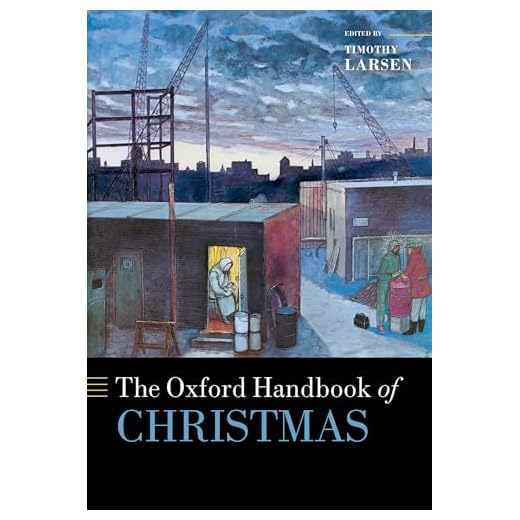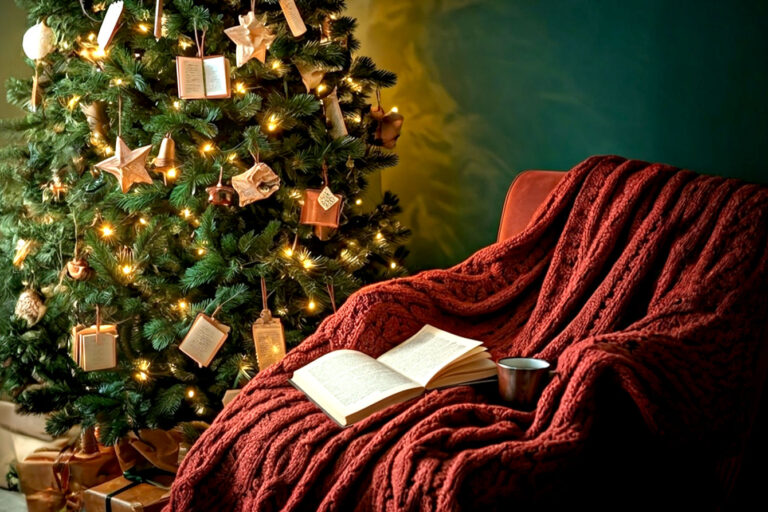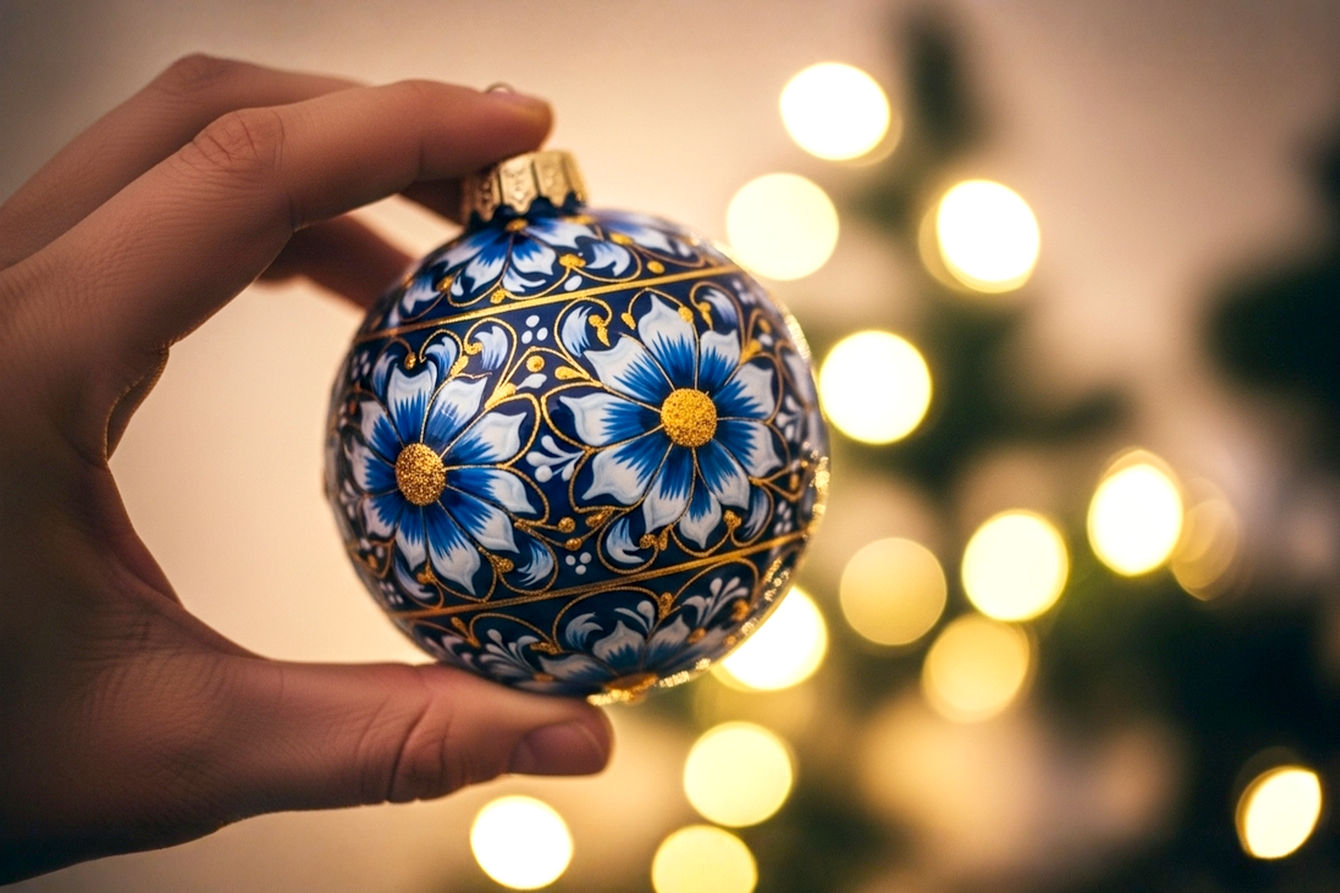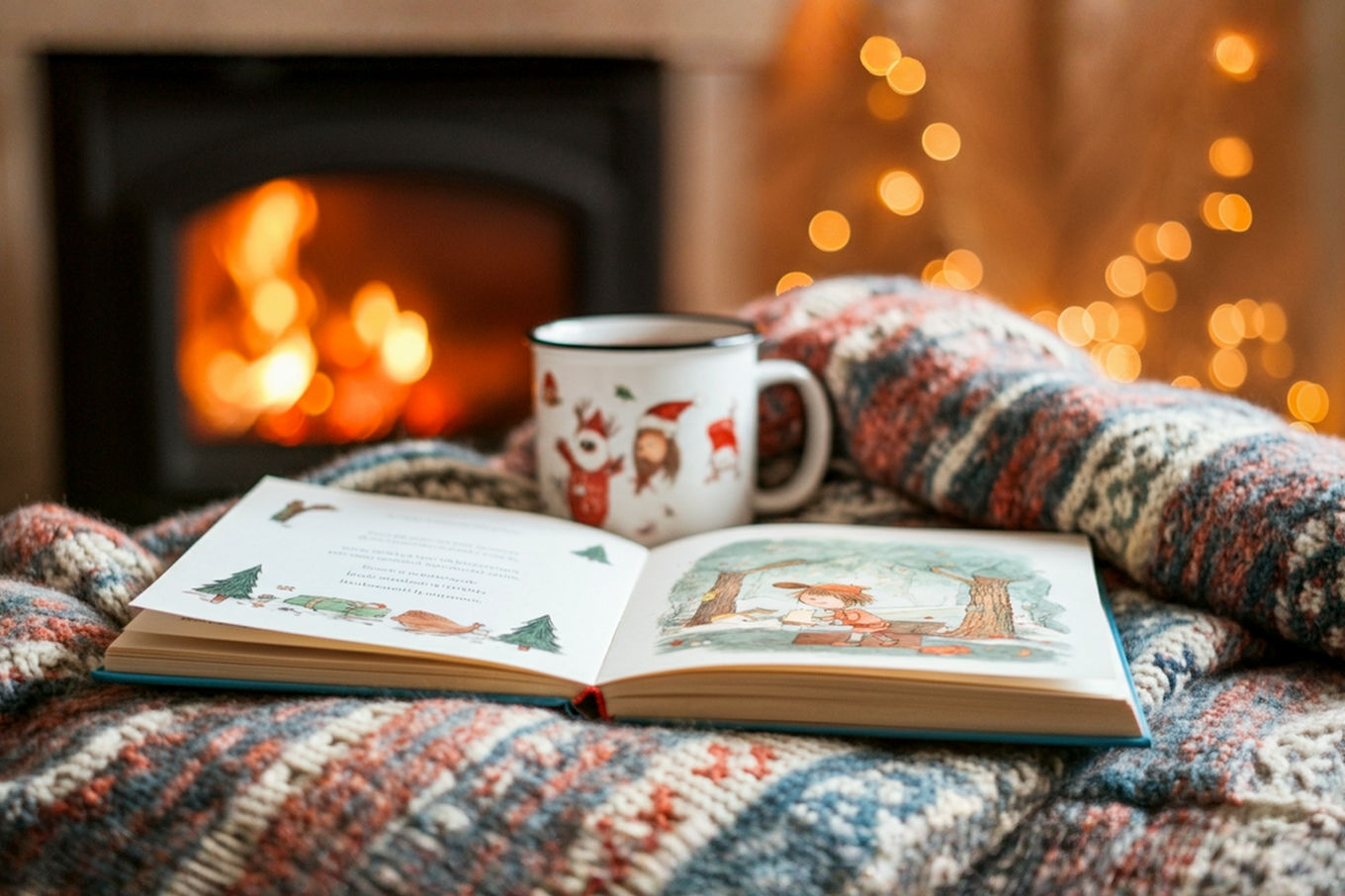This post may contain affiliate links. If you make a purchase through these links, we may earn a commission at no additional cost to you.
There’s a special kind of magic that happens when light hits a crystal ornament. It fractures into a thousand tiny rainbows, scattering across the room and painting the walls with fleeting colors. For so many of us, the Christmas tree isn’t truly complete until it’s adorned with these delicate, sparkling treasures. They’re more than just decorations; they are tiny vessels of memory, tradition, and artistry, each one holding a story that refracts and shines just like the light it catches.
But have you ever wondered where these shimmering heirlooms come from? Their story is a fascinating journey through time, from the humble beginnings of decorated fir trees in 16th-century Germany to the masterful craftsmanship of today’s world-renowned crystal houses. It’s a tale of innovation, artistry, and the simple human desire to capture light and hope during the darkest time of the year. This guide will explore that journey, uncovering the rich history, intricate craftsmanship, and enduring appeal of crystal Christmas ornaments. We’ll look at how they’re made, who the master artisans are, and why these delicate objects continue to hold such a powerful place in our hearts and holiday traditions.
-
Provides a comprehensive, interdisciplinary look at the history and culture of Christmas.
-
Features contributions from a global team of experts across multiple academic fields.
-
Explores a wide range of topics, from the Nativity story to modern consumerism.
Whether you’re a seasoned collector or just starting to build your own collection, you’ll find everything you need to know right here. We’ll share tips on how to identify, care for, and display your precious ornaments, ensuring they remain a cherished part of your family’s celebrations for generations to come. So, let’s step into the light and discover the timeless allure of crystal Christmas ornaments.
The Glimmer of History: From Apples to Artisan Glass
The tradition of decorating Christmas trees is much older than the crystal ornaments we know today. It all started in 16th-century Germany, where people began bringing evergreen trees into their homes to celebrate the holidays. In those early days, decorations were simple and symbolic. Apples were hung on the branches to represent the story of Adam and Eve, while candles were lit to symbolize the light of Christ. These natural adornments were beautiful, but they were also perishable and, in the case of candles, a significant fire hazard.
As the tradition spread across Europe and to America, the decorations began to evolve. People started making ornaments from paper, tin, and other readily available materials. But it was in the small German town of Lauscha, nestled in the heart of Thuringia, that the first glass ornaments were born.
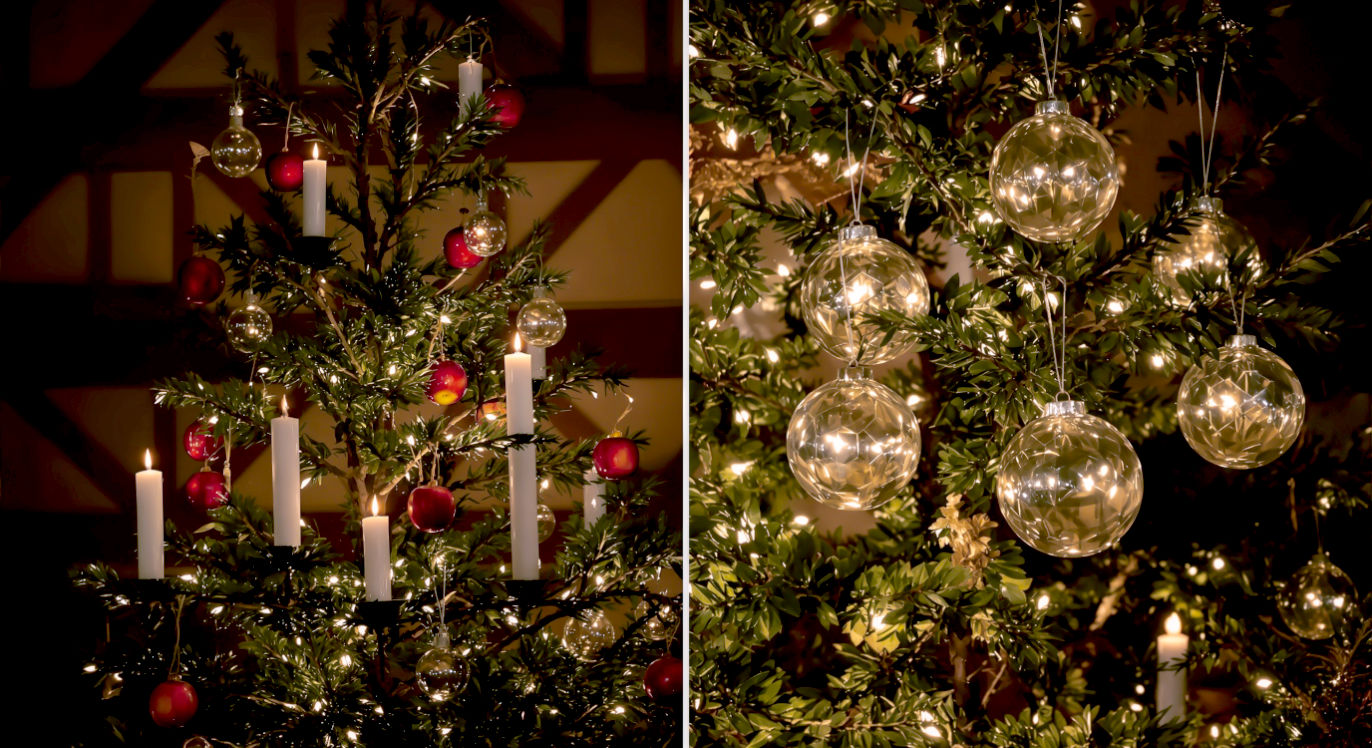
The Birthplace of Glass Ornaments: Lauscha, Germany
Lauscha was already a hub for glassmaking long before Christmas ornaments came into the picture. The town’s artisans were known for producing high-quality glassware, from drinking glasses to scientific equipment. In the 1840s, a local craftsman named Hans Greiner began producing glass beads and small, hollow glass shapes called “kugels” (the German word for globes or balls).
Legend has it that Greiner couldn’t afford the traditional apples and nuts to decorate his family’s Christmas tree, so he used his glassmaking skills to create his own durable, shimmering versions. These early glass ornaments were an instant hit with his neighbors, and soon, the entire town was in the business of making Christmas decorations.
The process was painstaking. Glassblowers would heat a glass tube over a flame, then blow into it to create a hollow ball. Once cooled, a solution of silver nitrate was swirled inside, giving the ornament a brilliant, reflective finish—a technique borrowed from mirror making. The outside was then painted with vibrant colors. For decades, Lauscha was the world’s primary producer of glass Christmas ornaments, and their intricate, hand-crafted designs were sought after across the globe.
The Crystal Revolution: A New Era of Brilliance
While Lauscha was perfecting the art of the glass ornament, another revolution was happening in the world of glassmaking itself. In the late 17th century, an English glassmaker named George Ravenscroft discovered that adding lead oxide to molten glass created a material that was heavier, clearer, and softer than traditional glass. This new material, known as lead crystal, had a much higher refractive index, meaning it could bend and scatter light in a way that regular glass simply couldn’t. When cut with facets, it sparkled with unparalleled brilliance.
It didn’t take long for artisans to see the potential of this new material for Christmas decorations. While traditional glass ornaments were beautiful for their color and shape, crystal ornaments offered something different: the pure, dazzling play of light. They didn’t need bright paints to stand out; their beauty came from their clarity and the precision of their cuts.
Companies that had already established themselves as masters of crystal tableware and chandeliers began turning their attention to the holiday market. Brands like Swarovski in Austria, Waterford in Ireland, and Baccarat in France started producing their own lines of crystal Christmas ornaments. These weren’t just simple baubles; they were intricate works of art, featuring detailed facets, delicate etchings, and timeless designs. This shift marked a new chapter in the history of Christmas decorations, one where craftsmanship and the pure beauty of the material took center stage.
-
Includes a set of six durable mercury glass ornaments in varied vintage designs.
-
Features both finial and ball shapes, suitable for any size Christmas tree.
-
Versatile enough for decorating trees, wreaths, garlands, and centerpieces.
The Art of the Sparkle: How Crystal Ornaments Are Made
Creating a crystal ornament is a delicate dance of fire, air, and human skill. It’s a process that has been refined over centuries, blending age-old techniques with modern precision. While every crystal house has its own secret formulas and signature styles, the fundamental steps of creating these sparkling treasures are a shared tradition. Let’s pull back the curtain and see how a simple mixture of sand and minerals is transformed into a dazzling work of art.
The Secret Recipe: What Is Crystal?
Before an ornament can be made, the crystal itself must be created. The basic ingredients are surprisingly simple: silica (a type of sand), potash (a salt derived from ashes), and lead oxide. It’s the lead oxide that’s the key ingredient, giving crystal its signature weight, clarity, and sparkle.
The quality of a piece of crystal is determined by its lead content. In the United States, glass must contain at least 1% lead to be classified as crystal. However, high-quality, full-lead crystal, the kind used by premier manufacturers like Waterford and Swarovski, typically contains between 24% and 33% lead oxide. This high lead content makes the glass softer and easier to cut, while also increasing its refractive index. The higher the refractive index, the more the crystal will sparkle when it catches the light—a quality often referred to as its “fire.”
These raw materials are mixed together to create a substance called “batch,” which is then shoveled into a furnace heated to an astonishing 2,400 degrees Fahrenheit (about 1,315 degrees Celsius). At this intense temperature, the batch melts into a glowing, honey-like liquid: molten crystal.
From Molten Glass to Delicate Form
Once the crystal is molten, the real artistry begins. There are two primary methods for shaping the ornament: mouth-blowing and pressing.
- Mouth-Blowing: This is the most traditional and labor-intensive method. A master glassblower, known as a gaffer, dips a long, hollow pipe into the furnace and gathers a “gob” of molten crystal on the end. The gaffer then blows through the pipe, inflating the crystal into a hollow shape, much like blowing a soap bubble. It takes incredible skill and control to achieve the perfect thickness and shape. While this technique is often used for rounded ornaments, skilled artisans can manipulate the molten crystal to create more complex forms.
- Molding or Pressing: For more intricate and uniform designs, a mold is used. A precise amount of molten crystal is poured or pressed into a pre-made mold. This method allows for the creation of detailed figures, snowflakes, and other complex shapes with perfect consistency. Many of Swarovski’s iconic annual ornaments are made using this technique, which allows for the sharp, precise facets the brand is known for.
The Art of the Cut: Unleashing the Fire Within
Once the ornament has been shaped and has slowly cooled in a special oven called an annealing lehr (a process that prevents it from cracking), it’s ready for the most critical step: cutting. An uncut piece of crystal is clear, but it doesn’t yet have its signature sparkle. It’s the facets cut into its surface that act like tiny prisms, catching, refracting, and splitting light into a brilliant spectrum of colors.
Highly skilled cutters use diamond-tipped wheels to meticulously carve patterns into the surface of the ornament. This is where the true identity of the piece is born. There are several classic cutting patterns:
- Wedge Cuts: These are deep, V-shaped cuts that create bold, geometric patterns. Waterford is famous for its intricate wedge cuts, like the classic “Lismore” and “Colleen” patterns.
- Flat Cuts: These are simple, flat facets that create large, clean surfaces, often used in more modern designs.
- Diamond Cuts: A series of cross-hatching cuts that create a pattern of tiny, sparkling diamonds on the surface.
The precision of the cutting is paramount. Even a tiny mistake can ruin the entire piece. Master cutters often work for years to perfect their craft, learning to judge the depth and angle of each cut by eye and feel.
The Finishing Touches
After cutting, the ornament can look a bit cloudy from the cutting process. To restore its brilliant clarity, it undergoes a final polishing. Traditionally, this was done by dipping the piece in a bath of acid, which would smooth out the microscopic scratches left by the cutting wheel. Today, many manufacturers use a combination of mechanical polishing and a less harsh acid-polishing process.
Finally, the ornament is inspected for any flaws. Only the pieces that are absolutely perfect will make it to market. A metal cap and hanging ribbon are attached, and the finished piece is carefully packaged, ready to begin its journey to a Christmas tree somewhere in the world. It’s a long and demanding process, but it’s this commitment to craftsmanship that transforms simple raw materials into a timeless object of beauty.
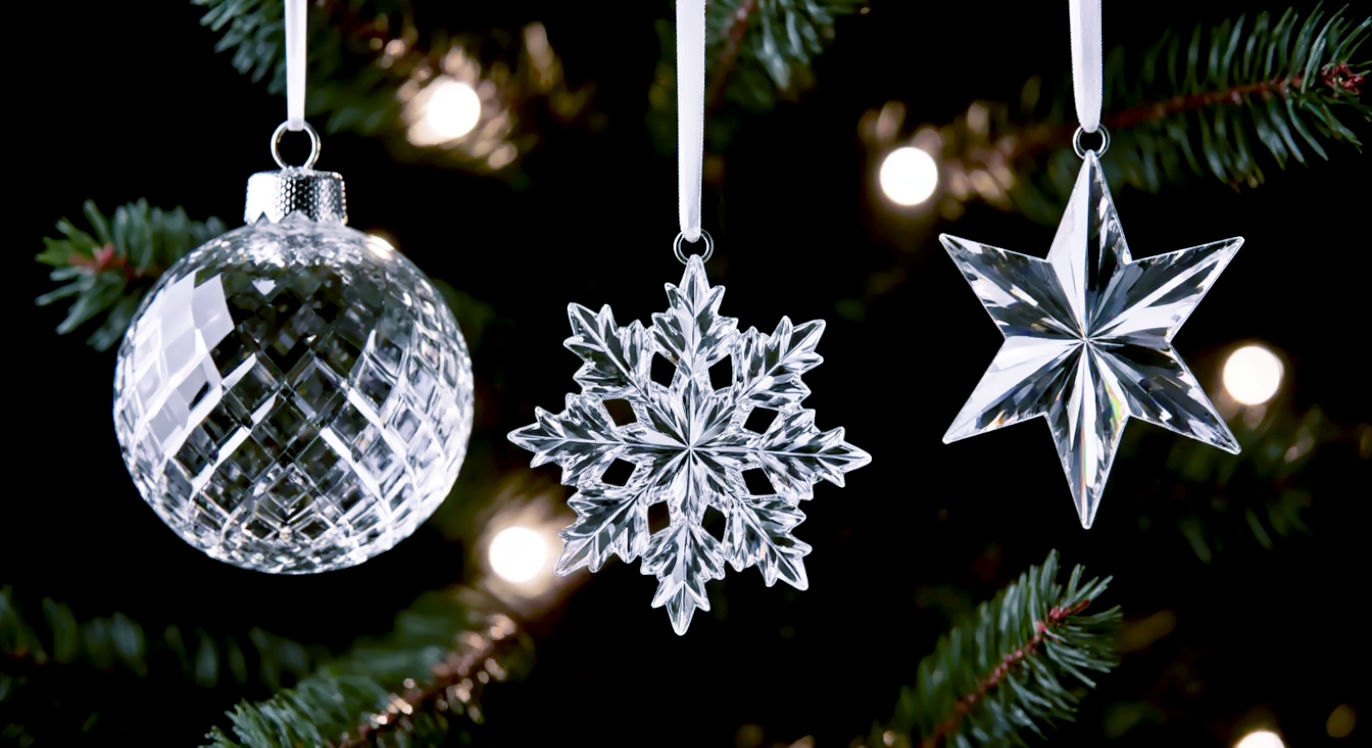
The Titans of Twinkle: Iconic Brands and Their Signatures
While many companies produce beautiful crystal ornaments, a few legendary names have come to define the industry. These brands are celebrated not just for the quality of their crystal but for their unique artistic vision and the traditions they’ve built over generations. For collectors, the name on the box can be just as important as the ornament inside. Let’s get to know the titans of the crystal world.
Swarovski: The Master of Precision and Brilliance
When you think of crystal, it’s hard not to think of Swarovski. Founded in 1895 by Daniel Swarovski in Wattens, Austria, the company revolutionized the crystal industry with its invention of a machine that could cut crystal with unprecedented precision. This technology allowed for the creation of small, perfectly faceted crystals that sparkled with an intensity never seen before.
- Signature Style: Swarovski is synonymous with sharp, clean lines and incredible brilliance. Their ornaments are not hand-cut in the traditional sense but are machine-cut and molded to achieve flawless geometric perfection. This results in an almost diamond-like sparkle.
- The Annual Edition Ornament: In 1991, Swarovski launched a tradition that would captivate collectors worldwide: the Annual Edition Christmas Ornament. Every year, they release a new, limited-edition snowflake or star design. Each ornament is engraved with the year of issue, making it a highly sought-after collectible. For many families, adding the new Swarovski annual edition to their tree is a cherished holiday ritual.
- Identifying Swarovski: Look for the iconic Swarovski swan logo, which is laser-etched onto most pieces. Older pieces might feature a square silver crystal logo or an edelweiss flower. The year of issue is also engraved on all annual edition ornaments.
Waterford: The Irish Legacy of Deep-Cut Crystal
Waterford Crystal has a rich and storied history that dates back to 1783 in the Irish harbor town of the same name. While the original factory closed in the mid-19th century, the brand was revived in 1947, carrying on the tradition of crafting deeply cut, heavy lead crystal. Waterford is not just a brand; it’s a symbol of Irish craftsmanship and heritage.
- Signature Style: Waterford is famous for its traditional, intricate wedge cuts. Patterns like Lismore, Colleen, and Alana feature a dense network of cuts that give the crystal a substantial feel and a soft, prismatic sparkle. Their ornaments often have a classic, heirloom quality to them.
- Popular Collections: Beyond their classic patterns, Waterford has created beloved annual collections. The “12 Days of Christmas” series, which features a different symbol for each of the twelve days, is a perennial favorite. They also release annual ornaments like stars, angels, and crosses, often updating the designs each year.
- Identifying Waterford: Authentic Waterford crystal will have the “Waterford” name etched on the piece, often in a gothic script. Sometimes, a seahorse logo is also included. The weight of the piece is another good indicator; Waterford crystal is noticeably heavy due to its high lead content.
Baccarat: French Elegance and Unmatched Clarity
As one of the oldest and most prestigious crystal manufacturers in the world, Baccarat has been a symbol of French luxury since its founding in 1764. Appointed by King Louis XV, Baccarat has created custom pieces for royalty, heads of state, and celebrities for over 250 years. Their crystal is renowned for its exceptional clarity and purity.
- Signature Style: Baccarat’s style is one of refined elegance and flawless quality. Their designs are often simpler and more modern than Waterford’s, focusing on the purity of the crystal itself. Their signature color, a stunning ruby red, is achieved by adding 24-karat gold to the molten crystal. An ornament featuring this iconic red is a true collector’s item.
- Iconic Ornaments: The Baccarat Annual Star Ornament is a holiday classic. Introduced in 1981, its design remains consistent, with only the year engraved on it changing. This makes it a timeless and elegant addition to any collection. They are also known for their exquisite Noel collection, which features a variety of festive designs.
- Identifying Baccarat: All Baccarat pieces are marked. You can find the Baccarat name and logo (a decanter, a goblet, and a tumbler) etched on the surface. The logo and signature can be very subtle, so you may need to look closely.
-
The collectible 2025 Annual Edition star, featuring an engraved tag for the year.
-
Showcases 170 precision-cut facets designed for maximum light reflection and sparkle.
-
Comes ready to hang from a green grosgrain ribbon with champagne gold-tone accents.
Other Notable Names
While Swarovski, Waterford, and Baccarat are often considered the “big three,” other brands have made significant contributions to the world of crystal ornaments:
- Lenox: An American company known for its fine china, Lenox also produces beautiful crystal and porcelain ornaments. Their style often blends classic and contemporary designs.
- Gorham: Another storied American brand, Gorham is famous for its annual sterling silver snowflake, but they also produce a popular crystal version that is highly collectible.
- Orrefors: A Swedish glassworks company known for its clean, Scandinavian design aesthetic. Their crystal ornaments are often characterized by their simplicity and elegance.
Each of these brands brings a unique history and artistic sensibility to their creations, offering collectors a wide world of styles to explore and cherish.
A Collector’s Guide: Building a Collection of Light
Collecting crystal Christmas ornaments is a rewarding hobby that can bring joy for years to come. A well-curated collection is more than just a box of decorations; it’s a sparkling timeline of memories, milestones, and personal style. Whether you’re just starting out or looking to grow an existing collection, here are some tips to help you on your journey.
Finding Your Focus: What Kind of Collector Are You?
Before you start buying, it’s helpful to think about what you want to collect. Having a focus can make your collection feel more cohesive and meaningful. Here are a few popular approaches:
- Collecting by Brand: This is one of the most common ways to collect. You might decide to collect only Swarovski annual snowflakes, Waterford’s “12 Days of Christmas” series, or Baccarat stars. This approach allows you to build a deep and comprehensive collection from a brand you love.
- Collecting by Theme: Perhaps you’re drawn to a particular motif. You could build a collection of crystal angels, stars, animals, or musical instruments. A thematic collection allows you to mix and match different brands and styles while maintaining a unified look.
- Collecting by Year: Many collectors buy one special ornament each year to mark the passage of time. This could be to celebrate a wedding, the birth of a child, a new home, or simply the year itself. This creates a beautiful, personal history of your family that you can revisit every Christmas.
- Collecting by Color: While most crystal is clear, many brands produce ornaments with color accents. You could build a stunning collection focused on a single color, like Baccarat’s signature red or Swarovski’s “Golden Shadow” pieces.
Of course, you don’t have to stick to just one approach! The most important rule of collecting is to buy what you love. Your collection should be a reflection of your own personal taste.
-
Gently cleans delicate jewelry, including pearls, semi-precious stones, and costume pieces.
-
Effectively revives brilliance and shine on gold and silver without removing tarnish.
-
The complete system includes an 8 oz. cleaning fluid, a dip tray, and a brush.
How to Spot a Treasure: Tips for Buying
Whether you’re shopping at a high-end department store, an antique shop, or an online marketplace, it’s important to know what you’re looking for.
- Check for Authenticity: Always look for the manufacturer’s mark or logo. As we discussed, each major brand has a unique signature. If you’re buying a valuable piece, especially from a secondary market like eBay, don’t be afraid to ask the seller for clear photos of the mark.
- Examine the Condition: Inspect the ornament carefully for any chips, cracks, or scratches. Hold it up to the light to check for internal flaws. For serious collectors, even a tiny chip can significantly decrease an ornament’s value.
- Original Packaging Matters: If you’re collecting for investment purposes, having the original box and any accompanying certificates of authenticity is crucial. This can make a big difference in the ornament’s resale value. For those who are collecting purely for sentimental reasons, the box is still important for safe storage.
- Understanding Value: The value of a crystal ornament is determined by several factors: its brand, rarity, condition, and desirability. Annual limited-edition pieces often increase in value over time, especially older, retired editions. Websites like Replacements, Ltd. or completed auction listings on eBay can give you a good idea of an ornament’s current market value.
Caring for Your Crystal: Preservation and Storage
Crystal is delicate and requires proper care to maintain its brilliance for generations.
- Cleaning: Dust and fingerprints can dull a crystal’s sparkle. To clean your ornaments, use a soft, lint-free cloth, like a microfiber or jewelry cloth. For a deeper clean, you can gently wash them in lukewarm water with a few drops of mild dish soap. Never use hot water, as the sudden temperature change can cause the crystal to crack. Avoid abrasive cleaners or brushes. After washing, rinse the ornament in clean lukewarm water and let it air dry or gently pat it dry with a lint-free cloth.
- Storage: Proper storage is the most important factor in preserving your collection.
- Keep the Original Boxes: The custom-fitted foam or fabric inserts in the original packaging are designed to protect your ornament perfectly.
- Use Acid-Free Tissue Paper: If you don’t have the original box, wrap each ornament individually in acid-free tissue paper. Regular tissue paper can yellow over time and potentially stain your crystal.
- Store in a Sturdy, Divided Container: Place your wrapped ornaments in a sturdy storage box with dividers to prevent them from knocking against each other.
- Avoid Extreme Temperatures: Store your collection in a cool, dry place with a stable temperature, like a closet or under a bed. Attics and basements can experience extreme temperature fluctuations and humidity, which can damage your ornaments over time.
By following these simple guidelines, you can ensure that your sparkling collection will remain a treasured part of your holiday celebrations for many years to come.
More Than Just Decoration: The Symbolism of Crystal
On the surface, a crystal ornament is an object of simple beauty. It sparkles on the tree, adds a touch of elegance, and reflects the warm glow of the Christmas lights. But if we look a little deeper, these shimmering objects hold a rich tapestry of meaning and symbolism that connects us to traditions, emotions, and the very spirit of the holiday season.
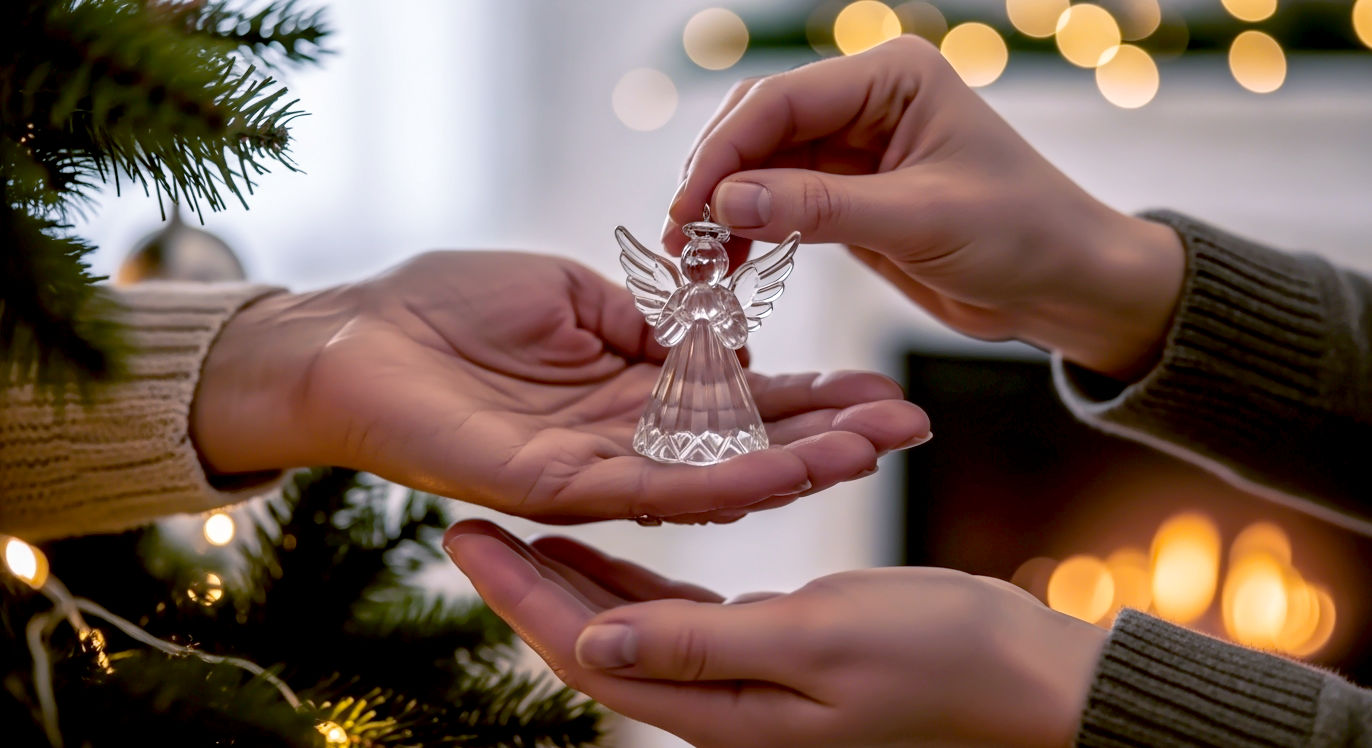
A Symbol of Light and Hope
At its core, Christmas is a festival of light in the midst of darkness. It takes place around the winter solstice, the shortest, darkest day of the year. Throughout history, cultures have marked this time with rituals meant to welcome the return of the sun and the promise of new life. The candles on the first Christmas trees were a literal representation of this, bringing light and warmth into the home.
Crystal ornaments are the modern embodiment of this ancient tradition. They don’t create light, but they capture and amplify it. A single ornament can take one small beam from a string of lights and multiply it, scattering it around the room in a dazzling display. In this way, they symbolize:
- Hope: In the same way that a prism reveals the hidden colors within a beam of white light, a crystal ornament can remind us of the hope and beauty that can be found even in the darkest of times.
- Purity and Clarity: The flawless, transparent nature of crystal is often associated with purity, truth, and spiritual clarity. Hanging these on our trees can be a quiet wish for a season of sincerity and peace.
- Celebration: The sheer joy and celebratory feel of a sparkling crystal is undeniable. Its brilliance is a visual representation of the happiness and magic of the holiday season.
Vessels of Memory and Tradition
Perhaps the most powerful symbolism of crystal ornaments is the one we give them ourselves. They are not just objects; they are markers of time and keepers of our memories. Think about the ornaments on your own tree. Each one tells a story.
- The “Baby’s First Christmas” ornament, a delicate crystal rocking horse, marks the year your family grew by one.
- The annual Swarovski snowflake that you and your mother have collected together since you were a child, a shimmering thread connecting your Christmases past and present.
- The simple crystal angel that belonged to your grandmother, its facets worn smooth with time, carrying with it the memory of her love and the holidays you shared.
When we unwrap these ornaments each year, we are unwrapping our own history. We remember the moments they represent, the people who gave them to us, and the Christmases they have witnessed. They become tangible links to our past, connecting generations and turning the act of decorating the tree into a meaningful family ritual. This, more than anything else, is what transforms a simple piece of cut glass into a priceless family heirloom.
The Enduring Legacy of Sparkle
In a world of fleeting trends and disposable decorations, the crystal ornament stands apart. Its appeal is timeless. It doesn’t rely on cartoon characters or flashy gimmicks. Its beauty is rooted in the fundamental principles of light, artistry, and craftsmanship.
As we move forward, these small treasures will continue to be a cherished part of our holiday celebrations. They are a quiet rebellion against the commercialism of the season, reminding us to slow down and appreciate the simple beauty of a well-crafted object and the precious memories it holds. They are a testament to the idea that the most valuable things in life are not things at all, but the traditions we build, the memories we share, and the light we find in each other. And as long as there are Christmas trees, there will be a place for the timeless, elegant sparkle of crystal.
Further Reading:
- Swarovski Crystal Society – The official site for collectors of Swarovski crystal.
- Waterford US – Explore the official collections and history of Waterford Crystal.

